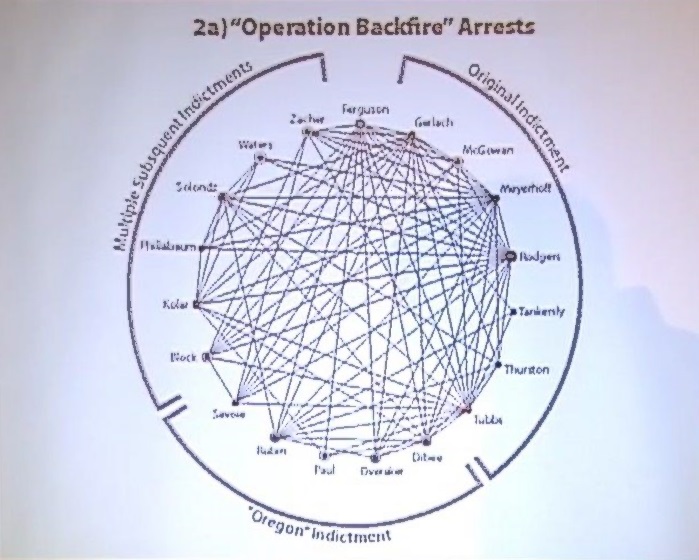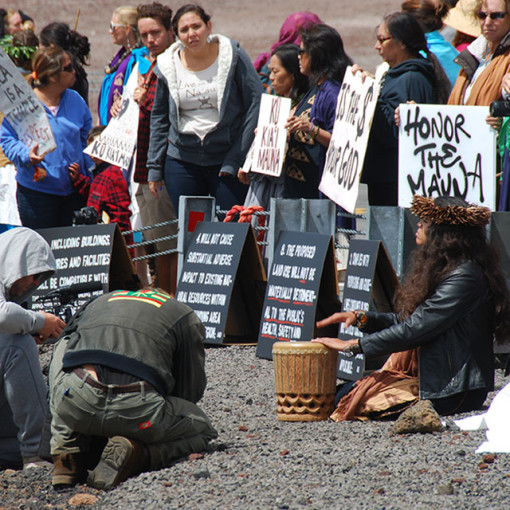
by DGR Colorado Plateau | Aug 21, 2015 | Colonialism & Conquest, Strategy & Analysis, White Supremacy
Editor’s Note: For further analysis of effective resistance movements, please visit the Deep Green Resistance Book, and read about our strategy: Decisive Ecological Warfare.
By Will Falk / Deep Green Resistance
When I am in Hawai’i, I ask everyone I meet if the United States will ever voluntarily de-occupy the Islands. No one ever says yes. Usually, before I can say anything else, people hurriedly start talking about the lack of a valid treaty or that the American occupation is illegal by their own laws or that the United States will pay for its human rights violations.
I am a haole in Hawai’i, a white settler in the United States. I acknowledge that every square inch of the United States of America exists on stolen native land. Leadership in land based struggles in the United States rests most properly in the hands of indigenous peoples. I will not undermine indigenous leadership, so I direct my thoughts to other settlers.
If no one believes that the United Sates will ever voluntarily de-occupy Hawai’i, why are so many of the movement’s settler supporters so focused on achieving this impossible voluntary withdrawal? Why, for example, do so many settlers spend so much energy supporting a parade in Oahu – a parade that is billed as a march for Hawaiian sovereignty while quietly being a voting drive to encourage participation in the occupying American government? Why do so many settlers hold up expensive court cases relying on American judges who are paid by the American government to make decisions leading to this mythical voluntary de-occupation as the only viable means for de-occupation?
The first answer is privilege. Settlers benefit from the current arrangement of power in Hawai’i. These Islands represent the tourist fantasy to many settlers despite the fact that Hawai’i’s life support systems are inches away from total collapse. The inability of settler support to recognize that Hawaiian de-occupation is our responsibility leads me to conclude that most settlers are not as concerned with Hawaiian liberation as they are concerned with maintaining a feel-good environment that balances settler crises of conscience while never threatening settler access to Hawai’i. Hawai’i does not have time to coax these settlers from their positions of privilege. So, I direct my thoughts to settlers of strong heart who simply suffer from a lack of analysis.
Apart from privilege, the second reason settlers have proven unable to mount a serious solidarity effort with the Hawaiian de-occupation movement is they see no alternative to a liberal mindset. “Wait a minute,” I hear a lot of confused readers saying, “Aren’t liberals good?” No, actually. It’s too late to rely exclusively on liberalism. Hawai’i has been cursed for 122 years of occupation with too much liberalism. Liberalism is the haoles’ game. Liberalism serves the United States of America. Liberalism renders resistance ineffective and must be forsaken if de-occupation is to be achieved.
The alternative is radicalism. An examination of the differences between the liberal and radical world views will demonstrate how radicalism arms settlers seeking to demonstrate true solidarity with a better analysis for forming an effective de-occupation strategy. This is not to say that a mixture of tactics cannot be effective. The Hawaiian de-occupation movement should not remove any tool from the table, but the longer Hawai’i remains occupied the clearer it becomes that decisive action is needed.
***
Before I begin, I would like to absolve the term “radical” of the bad reputation it has received in popular circles. Too many people confuse the word “radical” with the word “extreme.” But, as the great African-American activist Angela Davis has explained and as every major dictionary will tell you, the word radical simply means “getting to the root” and is most properly applied to political analyses that seek the origins of oppression.
The brilliant writer and activist Lierre Keith has pointed out two fundamental differences between liberals and radicals. The first difference revolves around individualism. Liberals believe that the basic social unit is the individual, while radicals believe the basic social unit is group or class. This reliance on individualism allows liberals to claim that every individual is entitled to their personal identity free from the realities accompanying social class. In fact, for many liberals, it is an insult to be identified with a certain group regardless of political reality.
For radicals, on the other hand, each individual is socially constructed by political reality. Radicals embrace their social group recognizing it as a source of strength. The first step to affecting change is making common cause with those who share your condition.
The other big difference between liberals and radicals is a disagreement on the nature of social reality. Liberals subscribe to a certain idealism while radicals root their analysis in materialism. For liberals, thoughts, mental states, and attitudes are the only sources and, therefore, solutions for oppression. Liberals locate reality in the human mind and tend to think that education is always the key to social change. For liberals, evil is a misunderstanding and if oppressors can just be shown the error of their ways, they will change.
How does this play out in Hawai’i? Take the role of white supremacism in the domination of Hawai’i, for example. Liberals, long ago, succumbed to the lie that racism and white supremacism are merely emotional states held in the hearts of individuals. They confine the definition of racism to hatred based on the color of one’s skin and confine the definition of white supremacism to hatred for everyone who is not white.
It is astronomers relying on a liberal definition of racism who can claim they are not racist because they hold no hatred in their hearts for the Hawaiian people while still insisting on destroying Mauna Kea’s summit to build telescopes. It is mining executives relying on a liberal definition of white supremacism who can claim no hatred in their hearts for native peoples while insisting that the guts be ripped from native land and poisons pumped into native waters to provide iron ore for the telescopes that destroy native peoples’ sacred sites.
Radicals see tangible systems of power maintained through force and working in the real, physical world as the sources and solutions of oppression. Education is an important first step to building radical consciousness, but they see organized political resistance and force as the means by which real change is achieved. Evil is not a misunderstanding. It is intentional and gives material benefits to oppressors. Oppression is always linked to resource extraction.
An emotional state – like hatred – might contribute to white supremacism, but radicals are less concerned with changing the hearts and minds of those murdering people of color and murdering the world, and more concerned with stopping the destruction. Hawaiian radicals, like Haunani-Kay Trask, for example, see racism as, “A historically created system of power in which one racial/ethnic group dominates another racial/ethnic group for the benefit of the dominating group.” White supremacism is the latest version of this system of power with white people dominating everyone else.
Racism and white supremacism establish, “Economic and cultural domination as well as political power…in the systemic dominance of the exploiting group.” Finally, radicals recognize, as Trask pointed out, that the dominating group holds a monopoly on the means on violence. It is this violence that must be confronted and dismantled if racism and white supremacism are ever truly going to be undermined.
To take this even further, consider what would happen if the liberal analysis was carried out to it’s logical conclusion. Imagine that liberals were actually successful at convincing those in power to treat every one in the world with love and kindness. Without a corresponding change in material reality, there would still be a huge problem. The dominant culture is built on the exploitation of natural resources. Resources are becoming scarcer and scarcer. Humans need to eat, for example, but topsoil is so depleted that major crops are all supported by oil. What will happen, despite the liberal conversion to loving kindness, when the dominant culture needs oil and indigenous peoples and others refuse to give up their lands to give them that oil?
***
A primary strength of the radical analysis is its ability to articulate the role power plays in oppression. Gene Sharp, the world’s foremost authority on civil disobedience and direct action tactics, has identified two manifestations of power – social and political. Social power, for Sharp, is “the totality of all influences and pressures which can be used and applied to groups of people, either to attempt to control the behavior of others directly or indirectly.” Political power is “the total authority, influence, pressure, and coercion which may be applied to achieve or prevent the implementation of the wishes of the power-holder.”
The powerful do everything they can to convince the oppressed that the current arrangement of power is inevitable. To believe power is inevitable is a mistake. Sharp says, “Power, in reality, is fragile, always dependent for its strength and existence upon a replenishment of its sources by the cooperation of a multitude of institutions and people – cooperation which may or may not continue.” The key to Hawaiian de-occupation, then, is dismantling American power. Power is dismantled most effectively by cutting it off at its sources.
Sharp lists six sources of power: authority, human resources, skills and knowledge, intangible factors, material resources, and sanctions. Jacques Maritain defines authority as “the right to command and direct, to be heard or obeyed by others” and Sharp notes that it is enough that those in power be perceived and accepted as superior. Human resources are simply defined as the number of people who obey those in power and will do their bidding. Those in power derive power from the skills, knowledge, and abilities of those who will do their bidding. Closely tied to skills and knowledge, intangible psychological and ideological factors like cultural history and spirituality can be leveraged by those in power to dominate others. Those in power need material resources like property, money, and sources of energy to maintain their power. Finally, those in power must have means to enforce obedience – punishment, in other words, for those who dissent.
The goal of any resistance movement aspiring to true success must engage in shrewd target selection to undermine these sources of power. Taking Sharp a step further, it is possible to prioritize which sources of power are more essential to the functioning of power than others. The most important sources of power are the material resources power depends upon and the brutality of the sanctions they can enact through their commitment to the exploitation of resources. All the other sources of power ultimately depend on the ability of those in power to enforce their power physically. This is a radical conclusion and can be easily demonstrated.
Consider the Overthrow. Did Queen Liliuokalani abdicate the throne because she believed in American authority or the inherent right of Americans to command Hawaiians? Did the Americans command more people to do their bidding in Hawai’i than the Queen? Was Queen Liliuokalani victim to some psychological failing that the Americans exploited?
The answer is obviously no. At the time, Kingdom of Hawai’i supporters outnumbered the Americans over 13 to 1 on the Islands and constituted 4/5 of the legally qualified voters in Hawai’i. Queen Liliuokalani abdicated the throne in order to avoid bloodshed and, according to her June 17, 1897 letter to President William McKinley, because she, “recognized the futility of a conflict with so formidable a power.”
Queen Liliuokalani abdicated the throne because there were 200 United States marines, holding rifles, standing outside her door. Again, it wasn’t the moral superiority of Americans that convinced the Queen. It was, quite clearly, the threat of violence. It is important to understand the physical processes that allowed the Americans to exert that kind of power in Hawai’i. Another way to understand this is to ask, How did a nation existing thousands of miles away on another continent succeed in pointing 200 rifles at Queen Liliuokalani? The answer is, superior material resources.
In order to occupy Hawai’i, Europeans had to get there first. The only way Europeans ever got to Hawai’i and then transported themselves in numbers great enough to gain power was through the use of large naval ships. In order to build these ships, those in power needed wood and lots of it. The U.S.S. Boston that provided the marines and firepower for the Overthrow was in fact one of the American navy’s first steel warships. In order to produce the steel needed to armor the U.S.S. Boston, iron ore must be harvested. To turn iron ore into steel, vast quantities of coal are needed. To mine sufficient quantities of coal, vast tracts of land housing this coal have to be ripped up. To gain access to these vast tracts of land to be ripped up, the indigenous peoples of that land have to be removed or destroyed.
It is true that the other sources of power support the exploitation of the natural world as we can see in the manufacturing of American naval ships. Coal mining, for example, requires human resources. Most humans will not voluntarily mine coal, so those in power have to employ a mixture of authority, psychological coercion, and pure violence to access the coal they need to exert more power. But, the whole system of violence requires material resources. No one is killed by authority alone. Mountain tops are not ripped off by simple knowledge. Belief systems, by themselves, do not colonize indigenous lands. Material action in the physical world produces power. Bullets, swords, or atomic bombs at various stages of human history kill people. Oil-powered excavators and dynamite blow the tops off mountains. Soldiers delivering blankets infected with small pox clear indigenous peoples off their land.
The good news is that the more destructive those in power become, the more complex their system of murder gets, the more opportunities they expose for dismantling their power. Each step in the manufacturing of the U.S.S Boston, for example, presents an opportunity for resisters to stop the replenishment of power at one of its sources. The method is simple. Restrict those in power access to the resources they require and their power weakens. Cut them completely off, and empire comes crashing down.
The physical processes that produce warships and put rifles and cannons in the hands of American troops in Hawai’i follow a similar pattern. These processes are ultimately what make civilization unsustainable. These processes demonstrate precisely how the civilized have come to dominate the world at the expense of the uncivilized and life on this planet. Again, this present state of the world is not inevitable. It is the result of power built through the exploitation of life on the planet. The problem for life right now is the American empire shows no signs of slowing. The bigger their weapons become the faster life is pushed to the brink of total extinction.
Radicalism, then – because it springs from material reality – gives the Hawaiian de-occupation movement an ecological imperative. European contact has resulted in half of Hawai’i’s endemic species being lost to extinction. How many more species must be lost before actions that truly reflect the seriousness of the situation are taken? The American empire is built on the use of fossil fuels and the American military is the single largest consumer of fossil fuels in the world. Burning fossil fuels must be stopped to avoid climate catastrophe. The American military presence is, perhaps, the most serious physical obstacle confronting the de-occupation movement. Blocking the military’s access to imported fossil fuels, then, could deal a decisive blow both to American power on the Islands and American environmental destruction.
***
This is the reality of the challenge confronting the Hawaiian de-occupation movement:The United States will never voluntarily leave Hawai’i and the survival of life on the Islands demands de-occupation. Too many settler liberals would have everyone believe that if Hawaiians just ask nicely enough, or cleverly enough, or with irrefutable American logic, the Americans will leave. Too many settler liberals hold up the American political and international legal systems as the only means for de-occupation. Too many settler liberals can be relied upon for sign-holding events, parades, and social media campaigns to achieve de-occupation, but when it comes down to being accomplices to Hawaiian liberation, we are failing.
Appealing to the American political system hasn’t worked in 122 years. Appealing to the international legal system misunderstands the material reality of power. These liberal tactics can be employed to erode American authority, to persuade humans not to support American power, but there are more decisive routes to undermining American power. It’s not that liberal tactics do not have their place. But, by themselves, they do not undermine power in any serious way.
Time is short in Hawai’i. Settlers wishing to demonstrate true solidarity need to embrace a radical analysis. It is time to get to work seriously dismantling the sources of American power.
Will Falk has been working and living with protesters on Mauna Kea who are attempting to block construction of an 18-story astronomical observatory.
Find an index of Will Falk’s “Protecting Mauna Kea” essays, plus other resources, at:
Deep Green Resistance Hawai’i: Protect Mauna Kea from the Thirty Meter Telescope
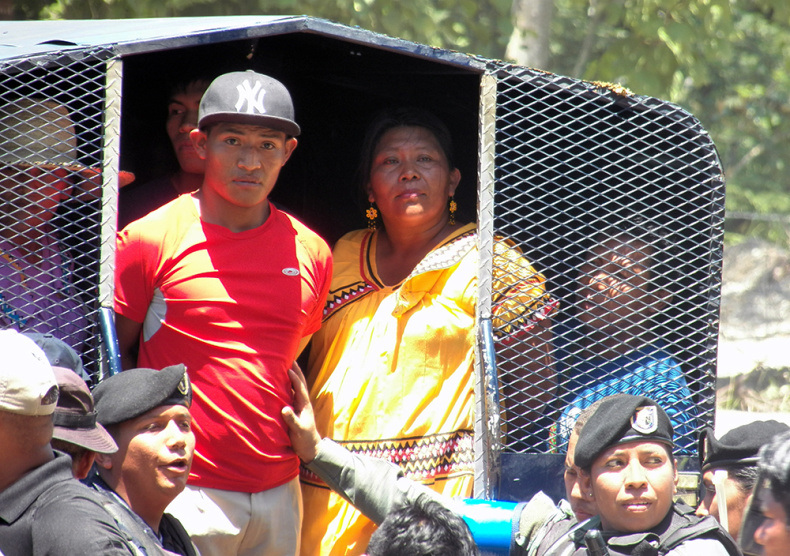
by DGR Colorado Plateau | Aug 6, 2015 | Colonialism & Conquest, Indigenous Autonomy, Obstruction & Occupation
By Richard Arghiris / Intercontinental Cry
Protests against the Barro Blanco hydro dam in western Panama turned violent last Saturday, July 25, when riot police, claiming to act in self-defense, unleashed pepper spray and batons on some 50 Ngäbe activists, women and children among them. At least three protesters were badly injured in the clash.
The crackdown occurred during a visit to the area by the Panamanian Vice President Isabel Saint Malo, who, under the pretext of dialogue, convened three Ngäbe leaders behind closed doors at the Centro Misionero (Mission Centre) in the town of Tolé. Despite a reasonable request to be included in the meeting, leaders from local community groups were excluded. Activists responded to Saint Malo’s move by blockading the Carretera Interamericana, the country’s principle highway.
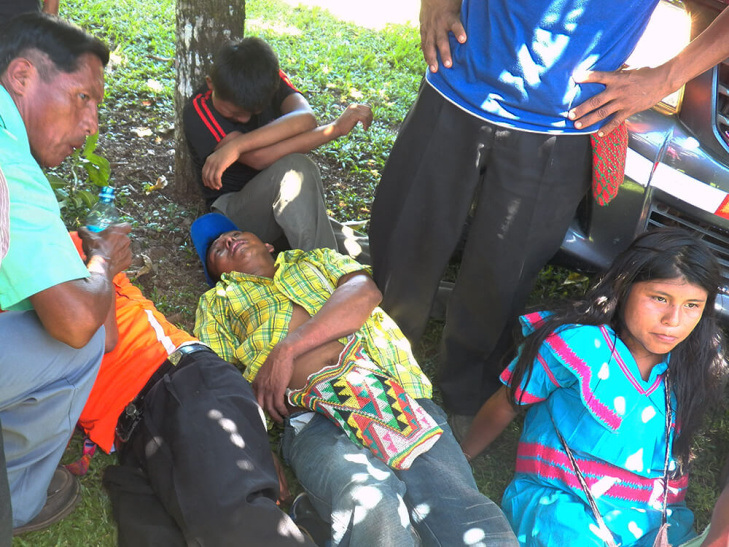
Protesters, including women and children, recover after clashes with the police. (Photo: Oscar Sogandares)
According to the Ngäbe, at around 10:15 am, in scenes reminiscent of the Martinelli years, the police reacted violently to disperse the 50-strong protesters, destroying their equipment, trashing their camps, and burning their banners.
The police deny improper use of force.
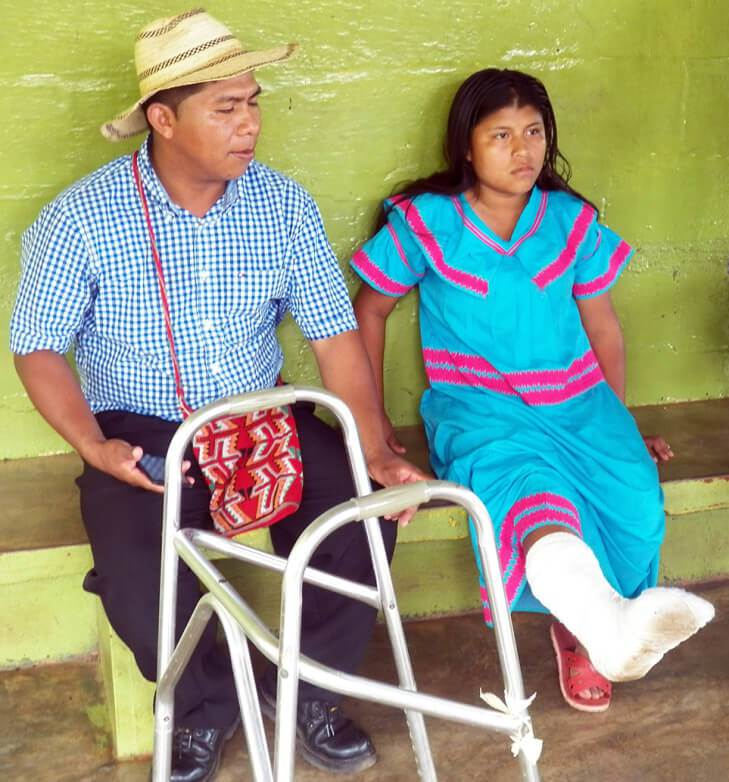
Edilma Pinto, 17, suffered a fractured foot during the police crackdown. (Photo: Oscar Sogandares)
Many fled the scene before 20 people were arrested (including several minors) and dispatched to the city of Santiago for processing.
While in the private meeting with Saint Malo, the Cacique of Muná, Chito Gallardo, and the Mayor of Muná, Rolando Carpintero, learned of the arrests and quickly intervened to have them returned. The injured were soon taken to the Casa Misionero for treatment and for the Vice President to bear witness.
According to one person at the scene, the vice president appeared coolly uninterested.
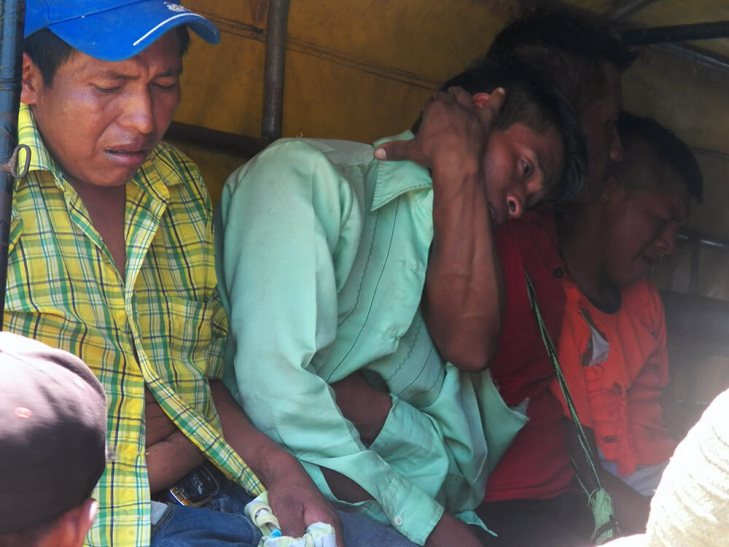
Some 20 Ngäbe protesters were detained by the police. (Photo: Oscar Sogandares)
For several weeks, hundreds of police units have been stationed in and around Tolé, including numerous SENAFRONT troops, an elite militarized squad funded in part by the United States. SENAFRONT is normally charged with defending the jungle frontier with Colombia, making their presence of considerable significance.
Under the US Leahy Law on Human Rights, the US Department of State is prohibited from providing military assistance to foreign units who violate human rights with impunity.
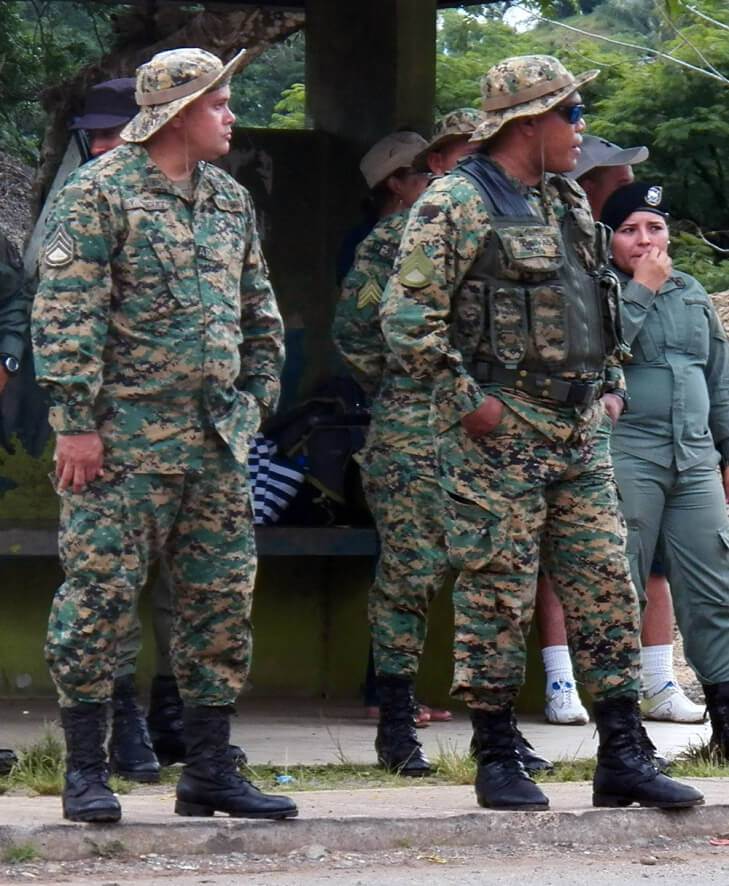
Partly funded by the US State Department, elite SENAFRONT troops have been dispatched to the area. (Photo: Oscar Sogandares)
The clashes on the Interamericana foreshadow greater unrest as Barro Blanco’s owner, Generadora del Istmo (GENISA) – a corporation owned by the controversial Kafie family, now mired in a high-level corruption scandal in Honduras – scrambles to complete the final 5-10% of the hydro dam’s construction.
The company has never sought the free, informed, and prior consent of the indigenous communities living on the banks of the Tabasará river, while the project’s funders, the Dutch and German investment banks FMO and DFE, admit to failing their own due diligence tests. Unfortunately, all funds have now been dispensed to GENISA and the banks themselves made a point of threatening the government when it suspended the project earlier this year.
The negative impacts of Barro Blanco have been identified by scores of technical teams, independent experts, international observers, and the United Nations. Those same impacts are nowhere to be found in GENISA’s Environmental Impact Assessment. Among them, the dam will displace several indigenous and campesino communities, including the community of Kiad, where a unique school and cultural centre is developing the written script of the Ngäbere language.
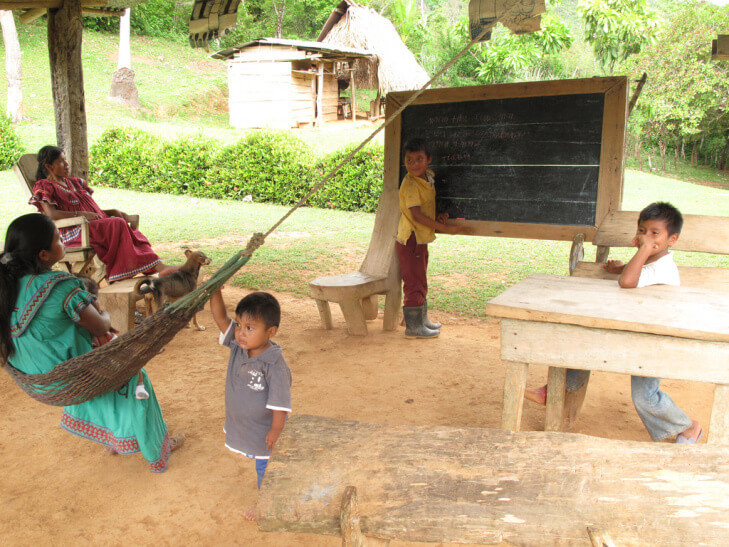
The ancient Ngabere language is taught at this school house in Kiad. (Photo: Richard Arghiris)
Additional impacts include the loss of farm plots and fish stocks — vital sources of sustenance for indigenous and campesino communities in the region – as well as the loss of several ancient petroglyphs, part of Panama’s national patrimony and a special significance to the Mama Tata religion, a Ngäbe revivalist movement that syncretises indigenous animism and Catholicism.
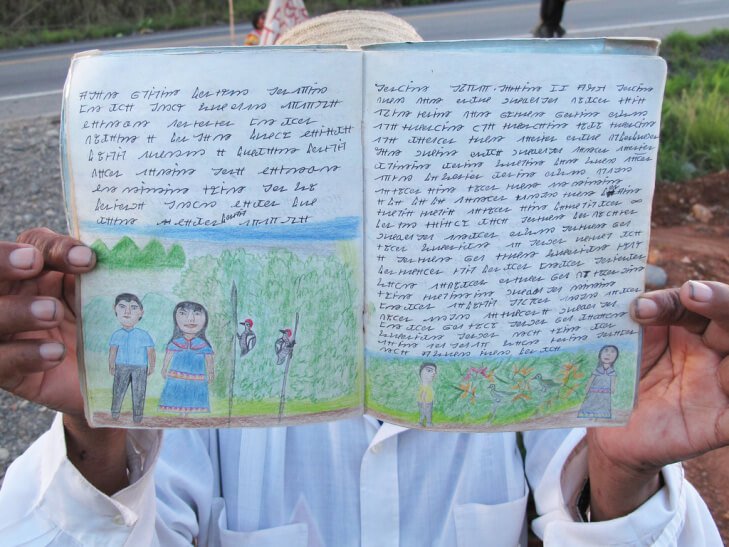
The Ngabere language is a great source of cultural pride. (Photo: Richard Arghiris)
Among the most devout followers of Mama Tata are the M22 resistance movement, who successfully blockaded the entrance to the dam for 38 consecutive days – until just ten days ago. International news footage of the groups praying and dancing on the highway may have influenced the government’s decision to enforce a ‘soft’ take-over of the site entrance. In contrast to the force deployed outside Tolé, Ngäbe women lying in the path of machinery were carefully removed.
Construction of the dam has now resumed and M22 are continuing to pray day and night by the highway. They complain of psychological intimidation with the police shining high intensity lamps on their camp during the night and aggressively entering the temple they have built near the river banks.
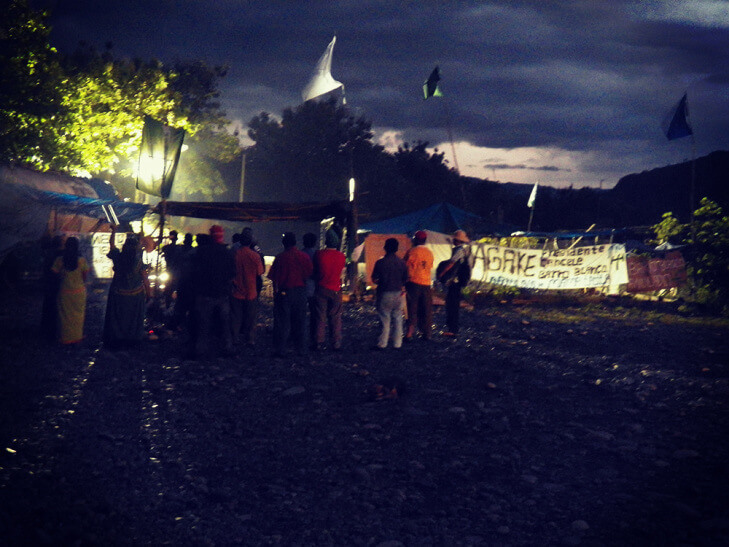
Days before their eviction from the site entrance, M22 gather for prayers under police spotlights. (Photo: Oscar Sogandares)
For his part, Panamanian President Varela, who continues to talk condescendingly about giving the Ngäbe ‘the keys to the dam’ upon its completion, appears to have acquiesced to pressures from his own business community, tacitly enabling foreign corporations who respect neither the environment nor international law nor indigenous or human rights.
The Supreme Court has cheered him on by annulling a moratorium on hydro projects passed by the environment agency, ANAM, who were concerned with the stress being placed on Panama’s delicate but biologically rich watersheds. With the crackdown last week, the Panamanian government appears officially back to business as usual.
From Intercontinental Cry: https://intercontinentalcry.org/barro-blanco-protesters-injured-and-arrested-28467/#imageclose-28472
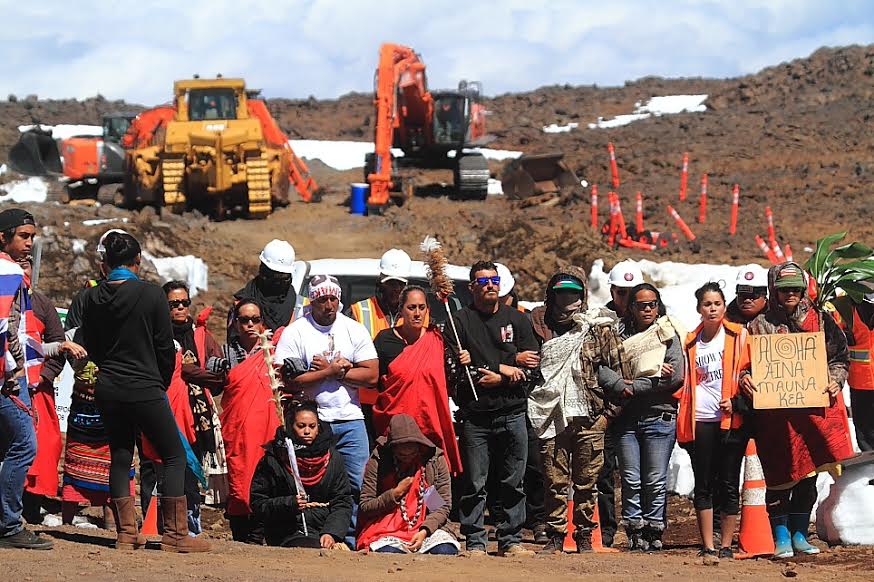
by DGR Colorado Plateau | Jul 9, 2015 | Colonialism & Conquest
By Will Falk / Deep Green Resistance
Sitting outside the 10 by 20 foot makeshift tent that has served as my home for the last 34 days on Mauna Kea, I watch the tent poles shudder to the concussion of US Army howitzer cannons firing live shells at their training grounds below. When the wind blows just right, from the south, the rattle of automatic rifle fire reaches the occupation. There’s no denying it: A war rages in Hawai’i.
It’s a war on native peoples, a war on women, a war on the land, a war on life itself. The war did not start in Hawai’i. The war began thousands of years ago with the dawn of civilization when some humans chose to live in population densities high enough that they overshot the carrying capacity of their homelands and turned to dominating other peoples in other lands. Imperialism was born, and one-by-one land-based, truly sustainable human societies were either eradicated or forced into assimilation.
The war swept west across Turtle Island (so-called North America) – where it is still being fought -leaving whole peoples destroyed and now largely forgotten. The war is carving peaks from mountains, drying rivers so they no longer flow to their ocean homes, and boiling the planet’s temperature to levels dangerously close to being unbearable for all but a few lifeforms. The war decimates the numbers of our animal kin, too. Buffalo walk the ledge above total extinction. So do salmon. So do timber wolves. So do grizzly bear.
The war in Hawai’i began in the late 1770s when Captain Cook first appeared. By 1897, a million Hawaiians were killed in battle, by introduced diseases, and through Christian missionary efforts. Half of Hawai’i’s endemic species have been exterminated since European contact. The minds of Hawaiian children were attacked when the illegal Republic of Hawai’i outlawed the Hawaiian language in Hawaiian schools in 1896. The bodies of these Hawaiian children were attacked when they were beaten for speaking their native tongue.
A genocidal program of desecration was initiated as well. Hale O Pa’pa and the Kanaka burials there were paved over by highways while Kahoolawe was bombed to hell by the American military – and that’s just to name a very few of the sites desecrated. Now, the TMT project wants to dynamite an eight acre patch of Mauna Kea’s hallowed summit to clear the way for their telescope.
***
Rumors are swirling that the TMT (Thirty Meter Telescope) project is poised to break its self-imposed moratorium on construction and send its equipment up the mountain with an armed escort. We have heard that Gov. David Ige is willing to send the national guard against the Mauna Kea protectors.
In the midst of these rumors, it is not uncommon to hear people say they hope the situation on Mauna Kea will not turn violent. The problem with expressing this hope is the situation on Mauna Kea is violent, has been violent for a long time, and will remain violent so long as those in power remain in control of the land.
Before you object to this, consider the bombs and rifle fire I am listening to as I write this.
Consider that the first time construction equipment tried to force a way over the objections of the Hawaiian people, it came with men carrying batons and pistols. These men carrying batons and pistols put 31 peaceful protectors in handcuffs, carried them to the Hilo jail, extracted 250 dollars from each one of them, and now force them to appear at a series of of court dates under threat of jail time.
Consider that David Ige, as I wrote earlier, has stated that he is willing to call in the national guard to clear the way for the TMT. Speaking of war, the national guard is an organization of soldiers. They will come with rifles instead of the police’s pistols.
This is violence.
I didn’t even mention the violence already done to Mauna Kea to build and maintain the 13 telescopes that already exist on the summit. These 13 telescopes required their own dynamite and 38 feet have been cut from the height of Mauna Kea’s summit already. There have been 7 reported mercury spills on the mountain that contains Hawai’i Island’s largest freshwater aquifer.
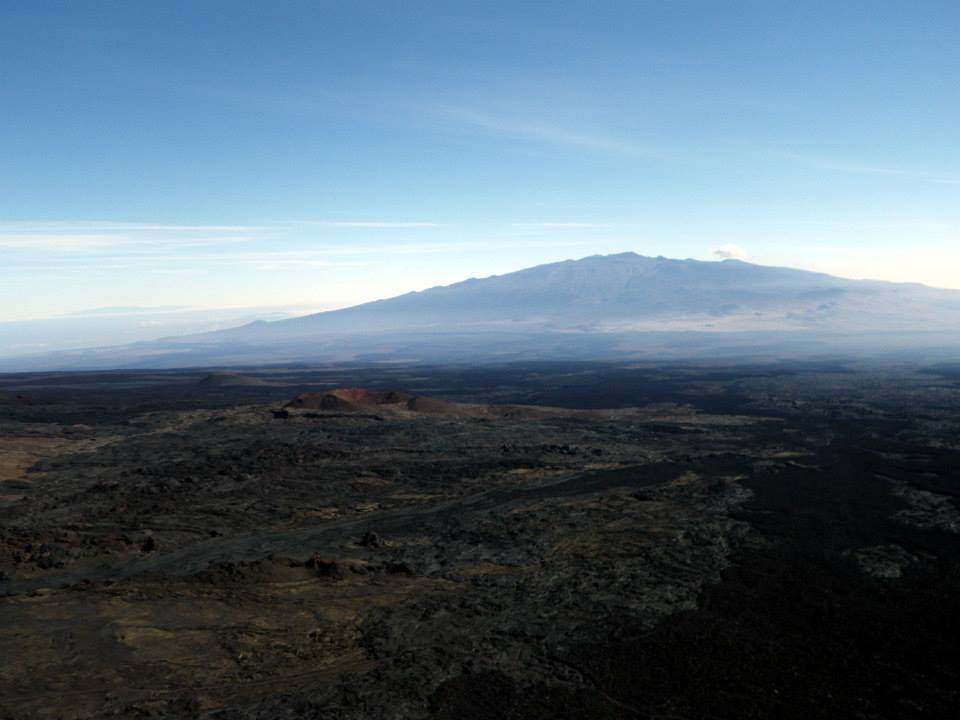
Mauna Kea
Plants, animals, and insects that live on Mauna Kea are murdered by this mercury and its more than likely that humans – especially children and the elderly – are harmed by this mercury, too.
Kanaka Maoli are genealogically related to Mauna Kea – it is literally a family member – so to do this kind of violence to the Mauna is to attack an older sibling.
Again, this is violence.
I anticipate that some may accuse me of encouraging an atmosphere of violence by using words like war to describe the violent reality facing Mauna Kea, facing Kanaka Maoli, and facing the long, necessary road to Hawaiian independence. Describing reality, however, is not the same thing as encouraging violence. I want this violence to stop and the first step to a cure is the proper diagnosis.
As a haole, I understand that when push comes to shove the State will crack down much harder on people of color than they will white people, and I do not want to provoke this crack down. I do think, though, that we need to be prepared to react when the State does not treat the protectors with the kapu aloha that the protectors will show those who come to destroy Mauna Kea.
Those who deny we are at war are wrong. Maybe, they cannot recognize the war because war has become so utterly pervasive. The wars of the past led to the rape of women. The war we’re fighting now causes one in six women to be raped in her lifetime worldwide. The wars of the past were fought to beat armies, to eradicate cultures, and to topple nations. The war we’re fighting now causes the extinction of whole species – 200 species a day, in fact, day after day after day.
Maybe, they cannot recognize the war because they are privileged enough not to confront the reality of this war. I think Palestinians understand this war. I think Catholics in Northern Ireland understand this war. I think Afghanis and Iraqis understand this war. I think hammerhead sharks, California condors, mamane trees, and ahinahina understand this war. They have to, because their survival depends on it.
Maybe, those who deny the war is happening think they can avoid the war’s dangers by ignoring it. It might be possible to avoid bullets, gas, and bombs by agreeing and cooperating with the cops as they place you in handcuffs, but you are just as susceptible to the environmental toxins the dominant culture unleashes on us every day. Denial saves no one from cancer.
Yes, Hawai’i with the rest of the world, is at war. This war – more than any other – is a war that we absolutely must win. If we lose, we lose life on this planet. To win a war, you must destroy your enemy’s ability to make war. The battle on Mauna Kea against the TMT is a mini-war in the larger war on life. The surest way to win this war is to undermine the TMT’s ability to build their telescope.
There are many strategies currently being employed to win this war – to undermine the TMT’s ability to build their telescope – but the weakness of most of these strategies is that they rely on our enemies to do the right thing. The countless sign-waving events conducted in support of Mauna Kea are designed to persuade the public of the justness of our movement. The incessant social media campaign we are waging is geared towards changing the hearts and minds of the world. The court cases challenging the TMT project, for example, rely on a judge to agree with the arguments made by our lawyers.
And why do we appeal to the courts to protect Mauna Kea? The answer is simple. If the judge rules in our favor, the decision will be backed with the full force of the State. The judge’s ruling and it’s enforcement will be backed with an organized group of men carrying guns – the police, or another organized group of men carrying bigger guns – the national guard. If we were to win in court and the TMT tried to build it’s telescope, it would be them and not us for once, who would be staring down the barrels of rifles. Of course, we do not trust the courts to do the right thing.
That’s why we stand on the Mauna Kea Access Road at this occupation.
Another way to say all this is: the State can, will, and already has used violence against us and our relations in the natural world. We must understand this in order to be effective. We must understand that writing really clever essays might not stop them. We must understand that hugging cops when they come to arrest us might not stop them. We must understand that we may not have an opportunity to place leis around the necks of national guardsmen when they point their guns at us.
I hear many people within the movement state confidently, “We will stop the TMT project.” But, if we do not understand the violence the State is capable of I feel like what we are really saying is “We will stop the TMT project as long as the police or the national guard agree to what we think are the rules.” I am not writing these things to cause despair. Rather, I am writing these things to encourage the deepest levels of commitment to protecting Mauna Kea.
Of course, those who think I am calling for violence demonstrate their own belief that only violence will stop the destruction of Mauna Kea, the destruction of Hawai’i, and the destruction of what is left of the world. I do not claim to know what will stop the destruction of Mauna Kea, but I do know that we must understand the way the State frames our tactics for us before we even begin. Once we understand this, we must ask tough questions.
I’ll walk my talk and begin: If the police or national guard overwhelms the protectors on the Mauna Kea Access Road, what do we do next?
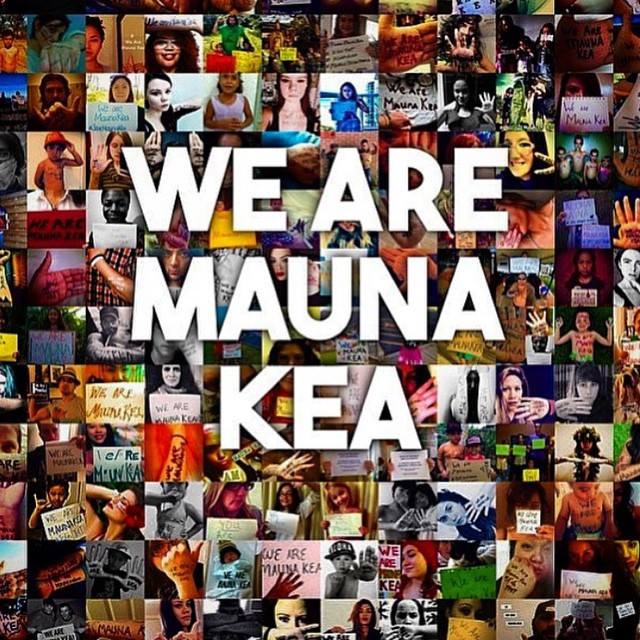
From San Diego Free Press: http://sandiegofreepress.org/2015/06/protecting-mauna-kea-this-is-a-war/
Find an index of Will Falk’s “Protecting Mauna Kea” essays, plus other resources, at:
Deep Green Resistance Hawai’i: Protect Mauna Kea from the Thirty Meter Telescope

by DGR Colorado Plateau | Apr 25, 2015 | Agriculture, Building Alternatives, Strategy & Analysis
In 1993 Michael Carter was arrested and indicted for underground environmental activism. Since then he’s worked aboveground, fighting timber sales and oil and gas leasing, protecting endangered species, and more. Today, he’s a member of Deep Green Resistance Colorado Plateau, and author of the memoir Kingfishers’ Song: Memories Against Civilization.
Time is Short spoke with him about his actions, underground resistance, and the prospects and problems facing the environmental movement. The first part of this interview is available here, and the third part here.
Time is Short: Your actions weren’t linked to other issues or framed in a greater perspective. How important do you think having well-framed analysis is in regards to sabotage and other such actions?
Michael Carter: It is the most important thing. Issue framing is one of the ways that dissent gets defeated, as with abortion rights, where the issue is framed as murder versus convenience. Hunger is framed as a technical difficulty—how to get food to poor people—not as an inevitable consequence of agriculture and capitalism. Media consumers want tight little packages like that.
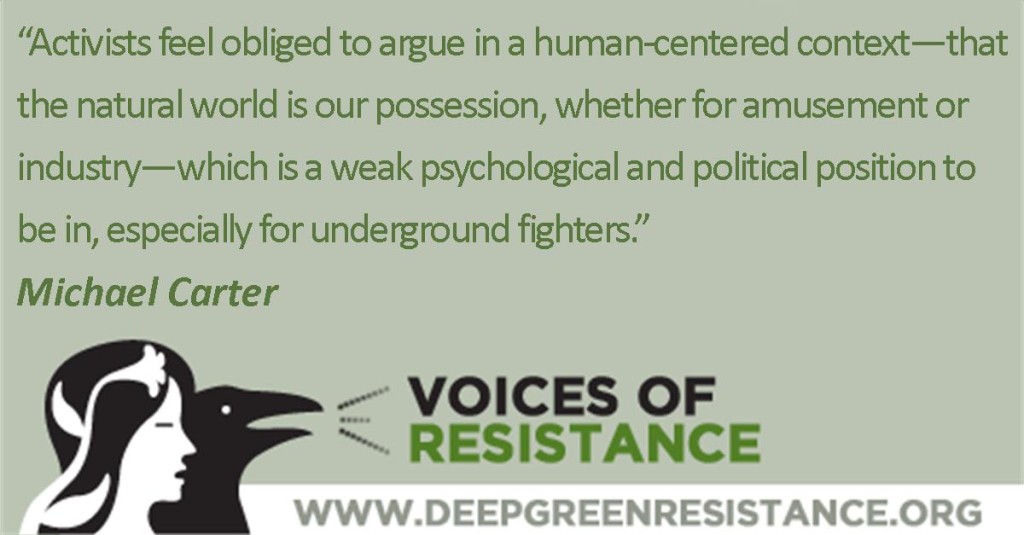
In the early ‘90s, wilderness and biodiversity preservation were framed as aesthetic issues, or as user-group and special interests conflict; between fishermen and loggers, say, or backpackers and ORVers. That’s how policy decisions and compromises were justified, especially legislatively. My biggest aboveground campaign of that time was against a Montana wilderness bill, because of the “release language” that allowed industrial development of roadless federal lands. Yet most of the public debate revolved around an oversimplified comparison of protected versus non-protected acreage numbers. It appeared reasonable—moderate—because the issue was trivialized from the start.
That sort of situation persists to this day, where compromises between industry, government, and corporate environmentalists are based on political framing rather than biological or physical reality—an area that industry or motorized recreationists would agree to protect might have no capacity for sustaining a threatened species, however reasonable the acreage numbers might look. Activists feel obliged to argue in a human-centered context—that the natural world is our possession, whether for amusement or industry—which is a weak psychological and political position to be in, especially for underground fighters.

Artwork by Stephanie McMillan
When I was one of them, I never felt I had a clear stance to work from. Was I risking a decade in prison for a backpacking trail? No. Well then what was I risking it for? I chose not to think that deeply, just to rampage onward. That was my next worst mistake after bad security. Without clear intentions and a solid understanding of the situation, actions can become uncoordinated, and potentially meaningless. No conscientious aboveground movement will support them. You can get entangled in your own uncertainty.
If I were now considering underground action—and of course I’m not, you must choose to be aboveground or underground and stick with it, another mistake I made—I would view it as part of a struggle against a larger power structure, against civilization as a whole. It’s important to understand that this is not the same thing as humanity.
TS: You called civilization a plan based on agriculture. Could you expand on that?
MC: Nothing else that the dominant culture does, industrial forestry and fishing, generating electricity, extracting fossil fuels, is as destructive as agriculture. None of it’s possible without agriculture. There’s some forty years of topsoil left, and agriculture is burning through it as if it will last forever, and it can’t. Topsoil is the sand in civilization’s hourglass, the same as fossil fuels and mineral ores; there is only so much of it. When it comes to physical limits, civilization has no rationality, or even a sense of its own ultimate self-interest; only a hidden-in-plain-sight secret that it’s going to consume everything. In a finite world it can never function for long, and all it’s doing now is grinding through the last frontiers. If civilization is still continuing twenty years from now, it won’t matter how many wilderness areas are designated; civilization is going to consume those wilderness areas.
TS: How is that analysis helpful? If civilization can never be sustained, doesn’t that remove any hope of success?
MC: If we’re serious about protecting life and promoting justice, we have to acknowledge that civilized humanity will never voluntarily take the steps needed for a sustainable way of life, because its history is entirely about war and occupation. That’s what civilization does: wage war and occupy land. It appears as though this is progress, that it’s humanity itself, but it’s not. Civilization will always make power and dominance its priority, and will never allow its priority to be challenged.
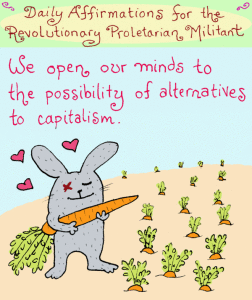
Artwork by Stephanie McMillan
For example, production of food could be fairly easily converted from annual grains to perennial grasses, producing milk, eggs, and meat. Polyface Farms in Virginia has demonstrated how eminently possible this is; on a large scale that would do enormous good, sequestering carbon and lowering diabetes, obesity, and pesticide and fertilizer use. But grass can’t be turned into a commodity; it can’t be stored and traded, so it can never serve capitalism’s needs. So that debate will never come up on CNN, because it falls so far outside the issue framing. Hardly anyone is discussing what’s really wrong, only which capitalist or nation state will get to the last remaining resources first and how technology might cope with the resulting crises.
Another example is the proposed copper mine at Oak Flat, near Superior, Arizona. The Eisenhower administration made the land off-limits to mining in 1955, and in December 2014 the US Senate reversed that with a rider to a defense authorization bill, and Obama signed it. Arizona Senator John McCain said, “To maintain the strength of the most technologically-advanced military in the world, America’s armed forces need stable supplies of copper for their equipment, ammunition, and electronics.” See how he justifies mining copper with military need? He’s closed the discussion with an unassailable warrant, since no one in power—and hardly anyone in the public at large—is going to question the military’s needs.
TS: Are you saying there’s no chance of voluntary reform?
MC: I’m saying that it’s going to be a fight. Significant social change is usually involuntary, contrary to popular notions about “being the change you want to see in the world” and “majority rules.” Most southern whites didn’t want the US Civil Rights Movement to exist, much less succeed. In the United States democracy is mostly a fictional theory anyway, because a tiny financial and political elite run the show.
For example, in the somewhat progressive state of Oregon, the agriculture lobby successfully defeated a measure to label foods containing genetically modified organisms. A majority of voters agreed they shouldn’t know what’s in their food, their most intimate need, because those in power had enough money to convince them. There’s little hope in trying to reason with the people who run civilization, or who are otherwise trapped by it, politically or financially or however. So long as the ruling class is able to extract wealth from the land and our labor, they will. If they’ve got the machinery and fuel to run their economy, they will eventually find the political bypasses to make it happen. It will consume lives and land until there’s nothing left to consume. When the soil is gone, that’s essentially it for the human species.

Oak Flat, Arizona
What’s the point of compromising with a political system that’s patently insane? A more sensible way of approaching the planet’s predicament would be to base tactical decisions on a strategy to strip power from those who are destroying the planet. This is the root, what we have to mean when we call it a radical—root-focused—struggle.
Picture a world with no food, rising temperatures, disease epidemics, drought, war. We see it unfolding now. This is what we’re fighting against. Or rather we’re fighting for a world that can live, a world of forests and prairies and free flowing rivers that build and stabilize soil and sustain biological diversity and abundance. Our love of the world must be what guides us.
TS: You’re suggesting a struggle that completely changes how humans have arranged themselves, the end of the capitalist economy, the eventual collapse of the nation-state model of society. That sounds impossibly difficult. How might resisters approach that?
MC: We can begin by building a movement that functions as a cultural replacement for the culture we’re stuck in now. Since civilized culture isn’t going to support anyone trying to take it apart, we need other systems of material, psychological, and emotional support.
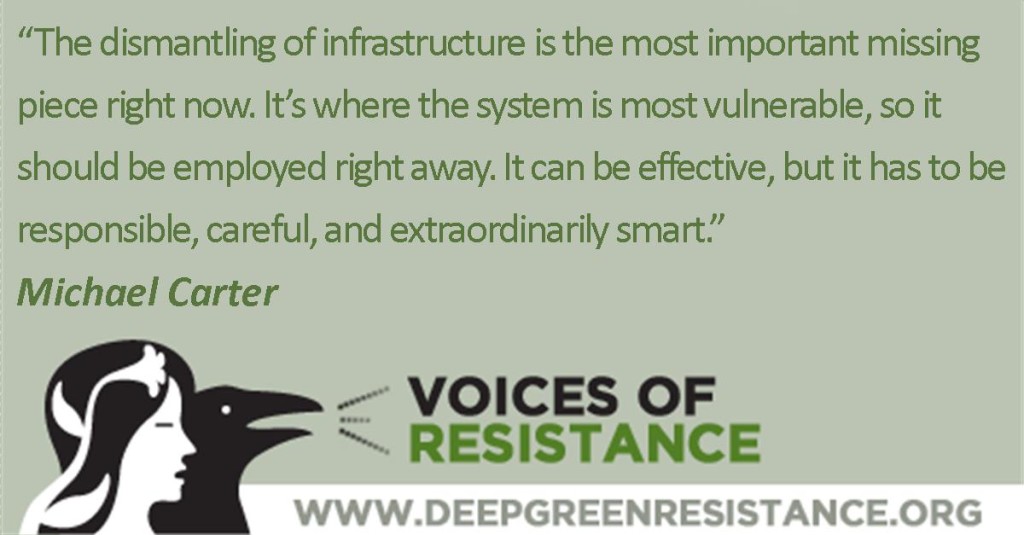
This would be particularly important for an underground movement. Ideally they would have a community that knows their secrets and works alongside them, just as militaries do. Building that network will be difficult to do in secret, because if they’re observing tight security, how do they even find others who agree with them? But because there’s little one or two people can do by themselves, they’ll have to find ways to do it. That’s a problem of logistics, however, and it’s important to separate it from personal issues.
When I was doing illegal actions, I wanted people to notice me as a hardcore environmentalist, which under the circumstances was foolish and narcissistic to the point of madness. If you have issues like that—and lots of people do, in our bizarre and hurtful culture—you need to resolve them with self-reflection and therapy, not activism. The most elegant solution would be for your secret community to support and acknowledge you, to help you find the strength and solidarity you need to do hard and necessary work, but there are substitutes available all the same.
TS: You’ve been involved with aboveground environmental work in the years since your underground actions. What have you worked on, and what are you doing now?
MC: I first got involved with forestry issues—writing timber sale appeals and that sort of thing. Later I helped write petitions to protect species under the Endangered Species Act. I burned out on that, though, and it took me a long time to get drawn back in. Aboveground people need the support of a community, too—more than ever. Derrick Jensen’s book A Language Older Than Words clarified the global situation for me, answered many questions I had about why things are so difficult right now. It taught me to be aware that as civilized culture approaches its end, people are getting ever more self-absorbed, apathetic, and cruel. Those who are still able to feel need to stand by each other as well as they can.
When Deep Green Resistance came into being, it was a perfect fit, and I’ve been focused on helping build that movement. Susan Hyatt and I are doing an essay series on the psychology of civilization, and how to cultivate the mental health needed for resistance. I’m also interested in positive underground propaganda. Having stories to support what people are doing and thinking is important. It helps cultivate the confidence and courage that activists need. That’s why governments publish propaganda in wartime; it works.
TS: So you think propaganda can be helpful?
MC: Yes, I do. The word has a negative connotation for some good reasons, but I don’t think that attempting to influence thoughts and actions with media is necessarily bad, so long as it’s honest. Nazi Germany used propaganda, but so did George Orwell and John Steinbeck. If civilization is brought down—that is, if the systems responsible for social injustice and planetary destruction are permanently disabled—it will require a sustained effort for many years by people who choose to act against most everything they’ve been taught to believe, and a willingness to risk their freedom and lives to bring it about. Entirely new resistance cultures will be needed. They will require a lot of new stories to sustain a vision of who humans really are, and what our lives are for, how they relate to other living things. So far as I know there’s little in the way of writing, movies, any sort of media that attempts to do that.
Edward Abbey wrote some fun books, and they were all we had; so we went along hoping we’d have some of that fun and that everything might come out all right in the end. We no longer have that luxury for self-indulgence. I’m not saying humor doesn’t have its place—quite the opposite—but the situation of the planet and social situation of civilization is now far more dire than it was during Abbey’s time. Effective propaganda should reflect that—it should honestly appraise the circumstances and realistically compose a response, so would-be resisters can choose what their role is going to be.
This is important for everyone, but especially important for an underground. In World War II, the Allies distributed Steinbeck’s propaganda novel The Moon is Down throughout occupied Europe. It was a short, simple book about how a small town in Norway fought against the Nazis. It was so mild in tone that Steinbeck was accused by some in the US government of sympathizing with the enemy for his realistic portrayal of German soldiers as mere people in an awful situation, and not superhuman monsters. Yet the occupying forces would shoot anyone on the spot if they caught them with a copy of the book. Compare that to Abbey’s books, and you see how far short The Monkey Wrench Gang falls of the necessary task.
TS: Can you suggest any contemporary propaganda?
Derrick Jensen’s Endgame books are the best I can think of, and the book Deep Green Resistance. There’s some negative-example propaganda worth mentioning, too. The book A Friend of the Earth, by T.C. Boyle. The movies “The East” and “Night Moves” are both about underground activists, and they’re terrible movies, at least as propaganda for effective resistance. “The East” is about a private security firm that infiltrates a cell whose only goals are theater and revenge, and “Night Moves” is even worse, about two swaggering men and one unprepared woman who blow up a hydroelectric dam.
The message is, “Don’t mess with this stuff, or you’ll end up dead.” But these films do point out some common problems of groups with an anarchistic mindset: they tend to belittle women and they operate without a coherent strategy. They’re in it for the identity, for the adrenaline, for the hook-up prospects—all terrible reasons to engage. So I suppose they’re worth a look for how not to behave. So is the documentary film “If a Tree Falls,” about the Earth Liberation Front.
Social change movements can suffer from problems of immaturity and self-infatuation just like individuals can. Radical environmentalism, like so many leftist causes, is rife with it. Most of the Earth First!ers I knew back in the ‘90s were so proud of their partying prowess, you couldn’t spend any time with them without their getting wasted and droning on about it all the next day. One of the reasons I drifted away from that movement was it was so full of arrogant and judgmental people, who seemed to spend most of their time criticizing their colleagues for impure living because they use paper towels or drive an old pickup instead of a bicycle.
This can lead to ridiculous guilt-tripping pissing matches. It’s no wonder environmentalists have such a bad reputation among the working class, when they’re indulging in self-righteous nitpicking that’s really just a reflection of their own circumstantial advantages and lack of focus on effectively defending the land. Tell a working mother to mothball her dishwasher because you heard it’s inefficient, see how far you get. It’s one of the worst things you can say to anyone, especially because it reinforces the collective-burden notion of responsibility for environmental destruction. This is what those in power want us to think. Developers build new golf courses in the desert, and we pretend we’re making a difference by dry-brushing our teeth. Who cares who’s greener than thou? The world is being gutted in front of our eyes.
Interview continues here.
Time is Short: Reports, Reflections & Analysis on Underground Resistance is a bulletin dedicated to promoting and normalizing underground resistance, as well as dissecting and studying its forms and implementation, including essays and articles about underground resistance, surveys of current and historical resistance movements, militant theory and praxis, strategic analysis, and more. We welcome you to contact us with comments, questions, or other ideas at undergroundpromotion@deepgreenresistance.org
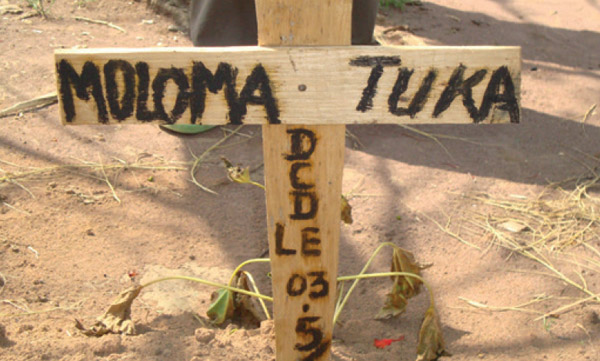
by DGR News Service | Apr 21, 2014 | Repression at Home
By Jeremy Hance / Mongabay
At least 908 people were murdered for taking a stand to defend the environment between 2002 and 2013, according to a new report today from Global Witness, which shows a dramatic uptick in the murder rate during the past four years. Notably, the report appears on the same day that another NGO, Survival International, released a video of a gunman terrorizing a Guarani indigenous community in Brazil, which has recently resettled on land taken from them by ranchers decades ago. According to the report, nearly half of the murders over the last decade occurred in Brazil—448 in all—and over two-thirds—661—involved land conflict.
“There can be few starker or more obvious symptoms of the global environmental crisis than a dramatic upturn in killings of ordinary people defending rights to their land or environment,” said Oliver Courtney of Global Witness. “Yet this rapidly worsening problem is going largely unnoticed, and those responsible almost always get away with it. We hope our findings will act as the wake-up call that national governments and the international community clearly need.”
But as grisly as the report is, it’s likely a major underestimation of the issue. The report covers just 35 countries where violence against environmental activists remains an issue, but leaves out a number of major countries where environmental-related murders are likely occurring but with scant reporting.
“Because of the live, under-recognized nature of this problem, an exhaustive global analysis of the situation is not possible,” reads the report. “For example, African countries such as Nigeria, Democratic Republic of Congo, Central African Republic and Zimbabwe that are enduring resource-fueled unrest are highly likely to be affected, but information is almost impossible to gain without detailed field investigations.”
In fact, reports of hundreds of additional killings in countries like Ethiopia, Myanmar, Venezuela, and Zimbabwe were left out due to lack of rigorous information.
Even without these countries included, the number of environmental activists killed nearly approaches the number of journalists murdered during the same period—913—an issue that gets much more press. Environmental activists most at risk are people fighting specific industries.
“Many of those facing threats are ordinary people opposing land grabs, mining operations and the industrial timber trade, often forced from their homes and severely threatened by environmental devastation,” reads the report. “Indigenous communities are particularly hard hit. In many cases, their land rights are not recognized by law or in practice, leaving them open to exploitation by powerful economic interests who brand them as ‘anti-development’.”
As if to highlight these points, Survival International released a video today that the groups says shows a gunman firing at the Pyelito Kuê community of Guarani indigenous people. The incident injured one woman, according to the group. The Guarani have been campaigning for decades to have land returned to them that has been taken by ranchers.
“This video gives a brief glimpse of what the Guarani endure month after month—harassment, intimidation, and sometimes murder, just for trying to live in peace on tiny fractions of the ancestral land that was once stolen from them,” the director of Survival International, Stephen Corry, said. “Is it too much to expect the Brazilian authorities, given the billions they’re spending on the World Cup, to sort this problem out once and for all, rather than let the Indians’ misery continue?”
According to the report, two major drivers of repeated violence against environmental activists are a lack of attention to the issue and widespread impunity for perpetrators. In fact, Global Witness found that only ten people have been convicted for the 908 murders documented in the report, meaning a conviction rate of just 1.1 percent to date.
“Environmental human rights defenders work to ensure that we live in an environment that enables us to enjoy our basic rights, including rights to life and health,” John Knox, UN Independent Expert on Human Rights and the Environment said. “The international community must do more to protect them from the violence and harassment they face as a result.”
From Mongabay: “Nearly a thousand environmental activists murdered since 2002“



















